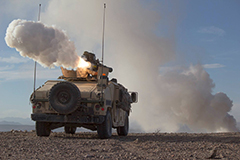TOW Anti Tank Missile
The BGM-71 TOW ("Tube-launched, Optically tracked, Wire-guided") is an American anti-tank missile. TOW replaced much smaller missiles like the SS.10 and ENTAC, offering roughly twice the effective range, a more powerful warhead, and a greatly improved semi-automatic guidance system that could also be equipped with infrared cameras for night time use.
First produced in 1970, the TOW is one of the most widely used anti-tank guided missiles. It can be found in a wide variety of manually carried and vehicle-mounted forms, as well as widespread use on helicopters. Originally designed by Hughes Aircraft in the 1960s, the weapon is currently produced by Raytheon.
The TOW missile in its current variations is not a fire-and-forget weapon, and like most second-generation wire-guided missiles has Semi-Automatic Command Line of Sight guidance. This means that the guidance system is directly linked to the platform, and requires that the target be kept in the shooter's line of sight until the missile impacts. A fire-and-forget TOW variant (TOW-FF) was under development, but was cancelled by the Army in 2002.
In October 2012, Raytheon received a contract to produce 6,676 TOW (wireless-guided) missiles for the U.S. military. Missiles that will be produced include the BGM-71E TOW 2A, the BGM-71F TOW 2B, the TOW 2B Aero, and the BGM-71H TOW Bunker Buster. By 2013, the U.S. Marine Corps had retired the air-launched TOW missile. More details
First produced in 1970, the TOW is one of the most widely used anti-tank guided missiles. It can be found in a wide variety of manually carried and vehicle-mounted forms, as well as widespread use on helicopters. Originally designed by Hughes Aircraft in the 1960s, the weapon is currently produced by Raytheon.
The TOW missile in its current variations is not a fire-and-forget weapon, and like most second-generation wire-guided missiles has Semi-Automatic Command Line of Sight guidance. This means that the guidance system is directly linked to the platform, and requires that the target be kept in the shooter's line of sight until the missile impacts. A fire-and-forget TOW variant (TOW-FF) was under development, but was cancelled by the Army in 2002.
In October 2012, Raytheon received a contract to produce 6,676 TOW (wireless-guided) missiles for the U.S. military. Missiles that will be produced include the BGM-71E TOW 2A, the BGM-71F TOW 2B, the TOW 2B Aero, and the BGM-71H TOW Bunker Buster. By 2013, the U.S. Marine Corps had retired the air-launched TOW missile. More details

